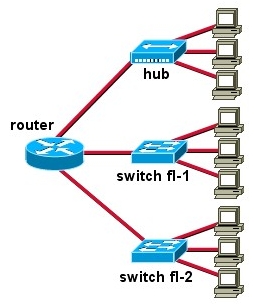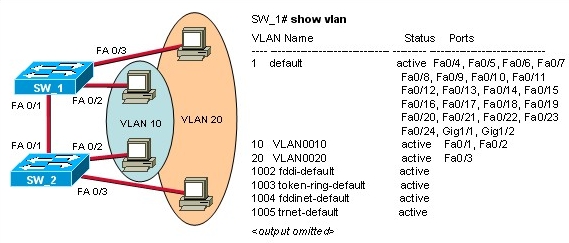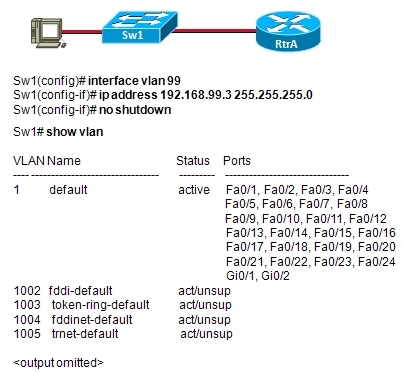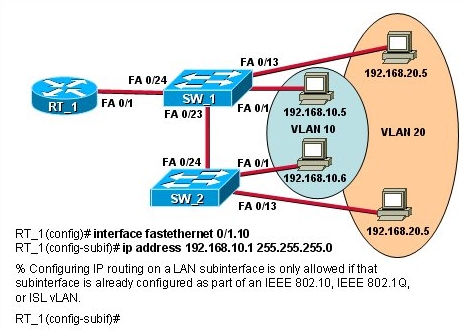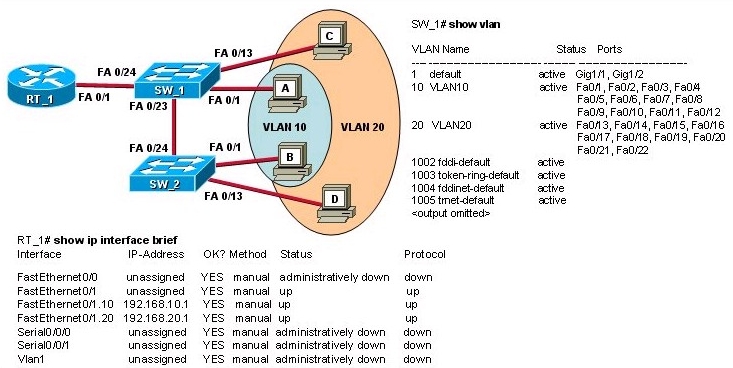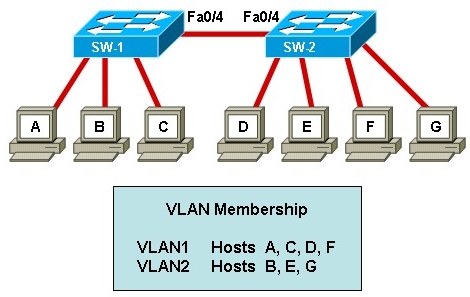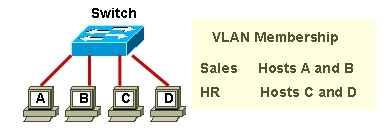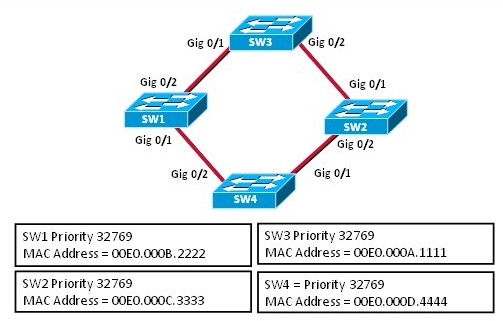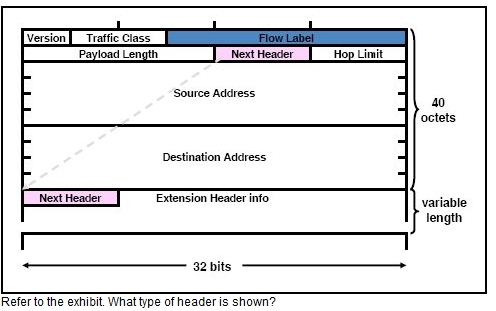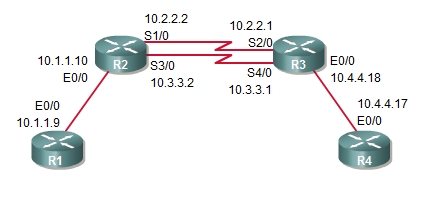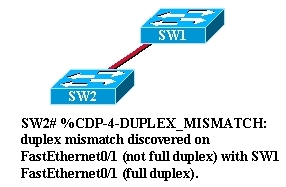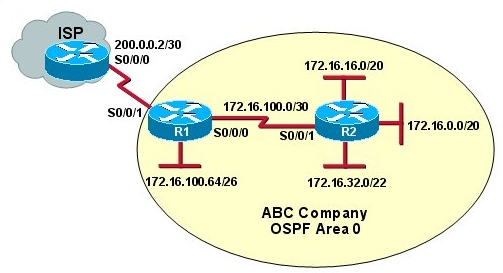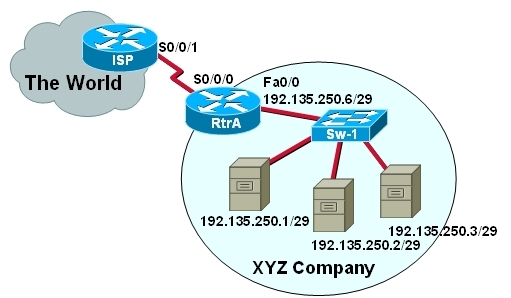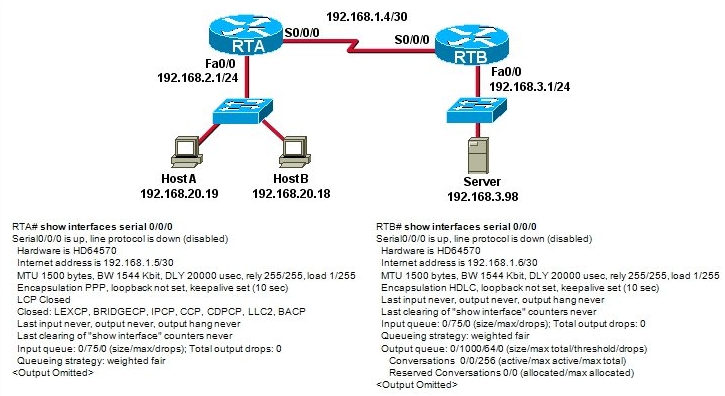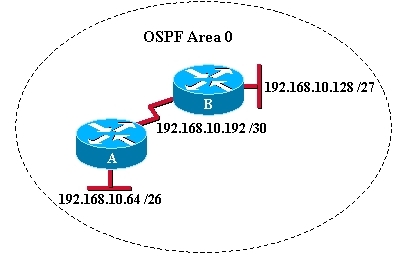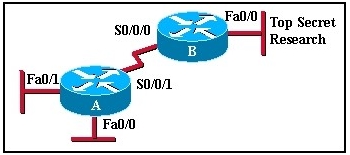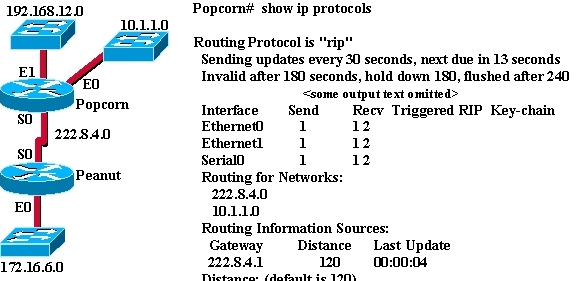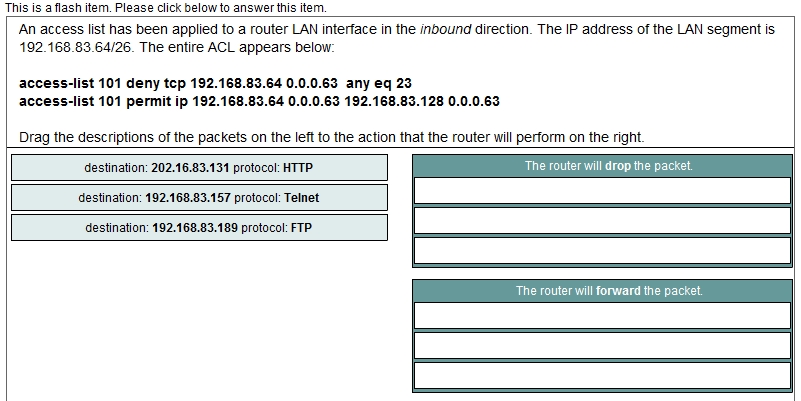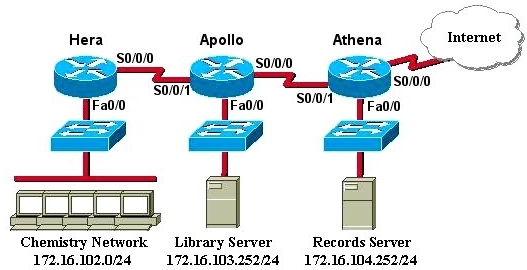CCNA Practice Certification Exam #1
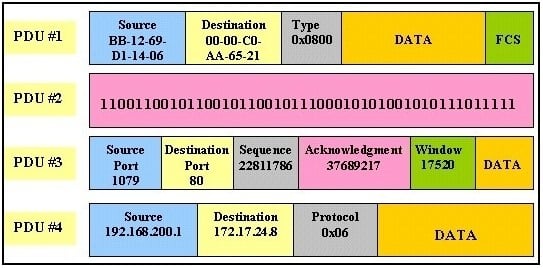
The Cisco Certified Network Associate aims to provide you with all the tools necessary in order to obtain a career in a wide variety of areas, such as engineering, systems administration and IT managing, among many others. Take this practice certification exam to see how close you are to acquiring such an important certification.
- 1.
What are three examples of TCP/IP application layer protocols? (Choose three.)
- A.
A terminal emulation protocol that supports remote console connections with various network devices
- B.
A protocol created by IBM that makes it easier for mainframes to connect to remote offices
- C.
A protocol responsible for transporting electronic mail on TCP/IP networks and the Internet
- D.
A protocol that controls the rate at which data is sent to another computer
- E.
A protocol that exchanges network management information between a network device and a management console
Correct Answer(s)
A. A terminal emulation protocol that supports remote console connections with various network devices
C. A protocol responsible for transporting electronic mail on TCP/IP networks and the Internet
E. A protocol that exchanges network management information between a network device and a management consoleExplanation
Three examples of TCP/IP application layer protocols are a terminal emulation protocol that supports remote console connections with various network devices, a protocol responsible for transporting electronic mail on TCP/IP networks and the Internet, and a protocol that exchanges network management information between a network device and a management console. These protocols are essential for various functions in a TCP/IP network, such as remote console connections, email communication, and network management.Rate this question:
-
- 2.
Refer to the exhibit. The exhibit shows simplified protocol data units from different OSI model layers. Which three statements are true about the PDUs and the encapsulation process? (Choose three.)
- A.
PDU #1 is a frame.
- B.
PDU #2 is an application layer PDU
- C.
PDU #3 is a segment.
- D.
PDU #4 is a transport layer PDU.
- E.
The order in which these PDUs are created during the encapsulation process is 3, 4, 1, 2.
Correct Answer(s)
A. PDU #1 is a frame.
C. PDU #3 is a segment.
E. The order in which these PDUs are created during the encapsulation process is 3, 4, 1, 2.Explanation
The given answer states that PDU #1 is a frame, PDU #3 is a segment, and the order in which these PDUs are created during the encapsulation process is 3, 4, 1, 2. This means that PDU #1 is created after PDU #4, which is a transport layer PDU, and before PDU #2, which is an application layer PDU. Additionally, PDU #3 is created before PDU #1 and PDU #2. Therefore, the correct answer is that PDU #1 is a frame, PDU #3 is a segment, and the order of creation is 3, 4, 1, 2.Rate this question:
-
- 3.
What are two characteristics of TCP? (Choose two.)
- A.
Data transport reliability
- B.
Best path determination
- C.
Establishing, maintaining, and terminating virtual circuits
- D.
Encapsulation of packets in a data frame with source and destination MAC addresses
- E.
Best-effort datagram delivery
Correct Answer(s)
A. Data transport reliability
C. Establishing, maintaining, and terminating virtual circuitsExplanation
TCP (Transmission Control Protocol) is a reliable transport protocol that ensures data transport reliability. It guarantees that data sent over a network is received correctly and in the correct order. TCP also establishes, maintains, and terminates virtual circuits, allowing for a reliable and ordered data transfer between two endpoints. These two characteristics make TCP a suitable choice for applications that require guaranteed delivery of data and a reliable connection between devices.Rate this question:
-
- 4.
Refer to the exhibit. What type of Layer 2 encapsulation will be used for connection D on the basis of this configuration on a newly installed router: RtrA(config)# interface serial0/0/0 RtrA(config-if)# ip address 128.107.0.2 255.255.255.252 RtrA(config-if)# no shutdown
- A.
Ethernet
- B.
Frame Relay
- C.
HDLC
- D.
PPP
Correct Answer
C. HDLCExplanation
Based on the given configuration, the type of Layer 2 encapsulation that will be used for connection D is HDLC. This can be inferred from the fact that there is no mention of any other encapsulation protocol being configured, such as PPP or Frame Relay. Therefore, the default encapsulation protocol, which is HDLC, will be used for this connection.Rate this question:
-
- 5.
Which three factors contribute to congestion on an Ethernet LAN? (Choose three.)
- A.
Improper placement of enterprise level servers
- B.
Addition of hosts to a physical segment
- C.
Replacement of hubs with workgroup switches
- D.
Increasing use of bandwidth intensive network applications
- E.
Migration to full-duplex Ethernet within the LAN
Correct Answer(s)
A. Improper placement of enterprise level servers
B. Addition of hosts to a physical segment
D. Increasing use of bandwidth intensive network applicationsExplanation
The three factors that contribute to congestion on an Ethernet LAN are the improper placement of enterprise level servers, the addition of hosts to a physical segment, and the increasing use of bandwidth intensive network applications. These factors can lead to an increase in network traffic and overload the LAN, causing congestion and slowing down the network performance.Rate this question:
-
- 6.
A Catalyst switch must be in which VTP mode in order to delete or add VLANs to a management domain?
- A.
Client
- B.
Server
- C.
Domain
- D.
Transparent
- E.
Designated
Correct Answer
B. ServerExplanation
In order to delete or add VLANs to a management domain in a Catalyst switch, it must be in server mode. In server mode, the switch can create, modify, and delete VLANs, and the changes will be propagated to other switches in the domain. The server mode is responsible for managing the VLAN database and synchronizing it with other switches.Rate this question:
-
- 7.
What creates a loop-free path through a switch network?
- A.
Hold-down timers
- B.
Poison reverse
- C.
Spanning Tree Protocol
- D.
Time to Live
- E.
Routing Information Protocol
Correct Answer
C. Spanning Tree ProtocolExplanation
The Spanning Tree Protocol creates a loop-free path through a switch network. It is a network protocol that prevents loops by dynamically selecting the best path for data transmission. It accomplishes this by identifying and blocking redundant paths, ensuring that there is only one active path between any two network devices. This helps to prevent broadcast storms and ensures efficient and reliable communication within the network.Rate this question:
-
- 8.
Refer to the exhibit. All ports on switch fl-1 are in the Production VLAN and all ports on switch fl-2 are in the Development VLAN. How many broadcast domains and how many collision domains are in the network? (Choose two.)
- A.
One broadcast domain
- B.
Three broadcast domains
- C.
Three collision domains
- D.
Five broadcast domains
- E.
Nine collision domains
Correct Answer(s)
B. Three broadcast domains
E. Nine collision domainsExplanation
In this network, there are two switches, fl-1 and fl-2, with all ports on fl-1 in the Production VLAN and all ports on fl-2 in the Development VLAN. Each VLAN represents a separate broadcast domain, so there are two broadcast domains in total.
For collision domains, each port on a switch represents a separate collision domain. Since there are 9 ports on fl-1 and 9 ports on fl-2, there are a total of 9 collision domains in the network.Rate this question:
-
- 9.
Refer to the exhibit. VLAN10 and VLAN20 have been created on SW_1 and SW_2 and switch ports have been assigned to the appropriate VLAN. Workstations in VLAN 10 can ping workstations in VLAN 10 that connect to either switch, but workstations in VLAN 20 cannot ping workstations in VLAN 20 on the opposite switch. Based on the output, what is most likely the problem?
- A.
FA 0/1 on SW_1 needs to be assigned to VLAN 20.
- B.
FA 0/1 on SW_2 needs to be assigned to VLAN 20.
- C.
VTP is not working properly between SW_1 and SW_2.
- D.
Interfaces FA0/1 on SW_1 and SW_2 need to be configured as trunk ports.
- E.
Interfaces FA0/3 on both switches need to be configured as access ports.
Correct Answer
D. Interfaces FA0/1 on SW_1 and SW_2 need to be configured as trunk ports.Explanation
Based on the information provided, workstations in VLAN 10 can communicate with each other regardless of which switch they are connected to. However, workstations in VLAN 20 cannot communicate with each other across switches. This suggests that there is an issue with the inter-switch connectivity for VLAN 20. To enable communication between VLANs across switches, the interfaces FA0/1 on both SW_1 and SW_2 need to be configured as trunk ports, allowing the transmission of multiple VLANs between the switches.Rate this question:
-
- 10.
Refer to the exhibit. What can be concluded from the output that is shown?
- A.
The management VLAN is VLAN 99.
- B.
The only VLAN that can be applied to switch ports is VLAN 99.
- C.
The only VLANs that can be applied to switch ports are VLANs 1 and 99.
- D.
The switch will only be able to forward frames for hosts on the 10.99.0.0 network.
Correct Answer
A. The management VLAN is VLAN 99.Explanation
The output shown in the exhibit indicates that the management VLAN is VLAN 99.Rate this question:
-
- 11.
Refer to the exhibit and the following error message from the SwA switch. 00:22:43: %SPANTREE-7-RECV_1Q_NON_TRUNK: Received 802.1Q BPDU on non trunk FastEthernet0/1 VLAN1.00:22:43: %SPANTREE-7-BLOCK_PORT_TYPE: Blocking FastEthernet0/1 on VLAN0001. Inconsistent port type. Considering that the link between the two switches is good and the correct type, what could cause this error message?
- A.
The Spanning Tree Protocol has been disabled on one switch.
- B.
The Spanning Tree Protocol has been disabled on both switches.
- C.
The IEEE 802.1Q trunking port has a speed mismatch on one of the switches.
- D.
The SwA port is configured as a trunk port and the SwB port is configured as an access port.
- E.
The SwA port has IEEE 802.1Q trunking enabled and the SwB port has ISL trunking enabled.
Correct Answer
D. The SwA port is configured as a trunk port and the SwB port is configured as an access port.Explanation
The error message indicates that there is an inconsistency in the port type between SwA and SwB. This means that one switch has its port configured as a trunk port, while the other switch has its port configured as an access port. The Spanning Tree Protocol (STP) is designed to prevent loops in a network, and it requires all ports on the same VLAN to have the same port type. In this case, the error message suggests that the SwA port is configured as a trunk port and the SwB port is configured as an access port, which is causing the inconsistency and triggering the error message.Rate this question:
-
- 12.
Refer to the exhibit. Based on the exhibited configuration and output, why is VLAN 99 missing?
- A.
Because there is a cabling problem on VLAN 99
- B.
Because VLAN 99 is not a valid management VLAN
- C.
Because VLAN 1 is up and there can only be one management VLAN on the switch
- D.
Because VLAN 99 needs to be entered as a VLAN under an interface before it can become an active interface
- E.
Because the VLAN 99 has not been manually entered into the VLAN database with the vlan 99 command
Correct Answer
E. Because the VLAN 99 has not been manually entered into the VLAN database with the vlan 99 commandExplanation
The VLAN 99 is missing because it has not been manually entered into the VLAN database with the "vlan 99" command. This command is necessary to create and activate VLAN 99 on the switch. Without this command, VLAN 99 will not be recognized or functional on the switch.Rate this question:
-
- 13.
Refer to the exhibit. Which command needs to be used on router interface Fa 0/1 to complete the VLAN configuration?
- A.
RT_1(config)# trunk encapsulation dot1q
- B.
RT_1(config-subif)# encapsulation dot1q 10
- C.
RT_1(config-subif)# encapsulation negotiate
- D.
RT_1(config-subif)# encapsulation 802.1q
- E.
RT_1(config)# vlan encapsulation dot1q
Correct Answer
B. RT_1(config-subif)# encapsulation dot1q 10Explanation
The correct answer is "RT_1(config-subif)# encapsulation dot1q 10". This command is used to configure the VLAN encapsulation on the router interface Fa 0/1. The "encapsulation dot1q" command is used to enable IEEE 802.1Q encapsulation, and the "10" specifies the VLAN ID. This command is necessary to complete the VLAN configuration on the interface.Rate this question:
-
- 14.
Refer to the exhibit. Computer A is configured with an IP address of 192.168.20.5 and cannot ping RT_1. What is most likely the problem?
- A.
SW_1 FastEthernet interface 0/24 is not a trunk port.
- B.
The RT_1 FastEthernet 0/1.10 is not configured for VLANs.
- C.
The FastEthernet port 0/1 on SW_1 is configured for VLAN 20.
- D.
The management VLAN does not have an IP address assigned to the same VLAN.
- E.
The IP address of computer A is incorrect.
Correct Answer
E. The IP address of computer A is incorrect.Explanation
The most likely problem is that the IP address of computer A is incorrect. This is because the question states that computer A cannot ping RT_1, which suggests a connectivity issue. Since computer A is configured with an IP address of 192.168.20.5, it is possible that this IP address is not in the same network as RT_1, causing the ping to fail.Rate this question:
-
- 15.
Refer to the exhibit. Which three hosts will receive ARP requests from host A, assuming that port Fa0/4 on both switches is configured to carry traffic for multiple VLANs? (Choose three.)
- A.
Host B
- B.
Host C
- C.
Host D
- D.
Host E
- E.
Host F
Correct Answer(s)
B. Host C
C. Host D
E. Host FExplanation
Host A will send ARP requests to hosts B, C, and F because they are connected to the same VLAN as Host A. Hosts D and E are connected to different VLANs, so they will not receive ARP requests from Host A.Rate this question:
-
- 16.
Refer to the exhibit. Two VLANs have been configured on the switch and hosts have been assigned. Hosts in the Sales VLAN can ping all hosts in their own VLAN, but cannot ping the hosts in the HR VLAN. What are two explanations for this problem? (Choose two.)
- A.
All hosts are in one collision domain.
- B.
All hosts are in one broadcast domain.
- C.
A router is required for communication between VLANs.
- D.
The hosts are in separate broadcast domains.
- E.
The management VLAN has not been assigned an IP address.
Correct Answer(s)
C. A router is required for communication between VLANs.
D. The hosts are in separate broadcast domains.Explanation
The first explanation for the problem is that a router is required for communication between VLANs. VLANs are separate virtual networks and by default, they cannot communicate with each other without a router to route the traffic between them. The second explanation is that the hosts are in separate broadcast domains. Each VLAN is its own broadcast domain, and hosts within a VLAN can communicate with each other using broadcast messages. However, hosts in different VLANs cannot communicate using broadcast messages.Rate this question:
-
- 17.
Which industry-wide specification was developed to decrease the time that is needed to move to the forwarding state by switch ports that are operating in a redundantly switched topology?
- A.
VLSM
- B.
PVST
- C.
802.1Q
- D.
RSTP
- E.
VTP
Correct Answer
D. RSTPExplanation
RSTP (Rapid Spanning Tree Protocol) is an industry-wide specification developed to decrease the time needed to move to the forwarding state by switch ports operating in a redundantly switched topology. RSTP improves the convergence time of the Spanning Tree Protocol (STP) by reducing the amount of time it takes for a switch to transition from blocking to forwarding state. This allows for faster network recovery and improved performance in redundant network topologies. VLSM (Variable Length Subnet Masking), PVST (Per VLAN Spanning Tree), 802.1Q (VLAN Trunking Protocol), and VTP (VLAN Trunking Protocol) are not directly related to decreasing the time to move to the forwarding state in a redundant switched topology.Rate this question:
-
- 18.
Refer to the exhibit. Which switch will be elected the root bridge and which switch will place a port in blocking mode? (Choose two.)
- A.
SW1 will become the root bridge.
- B.
SW2 will become the root bridge.
- C.
SW2 will get a port blocked.
- D.
SW4 will get a port blocked.
- E.
SW3 will become the root bridge.
Correct Answer(s)
D. SW4 will get a port blocked.
E. SW3 will become the root bridge.Explanation
SW3 will become the root bridge because it has the lowest bridge ID. SW4 will get a port blocked because it has the highest bridge ID among the switches that are not elected as the root bridge.Rate this question:
-
- 19.
What is the purpose of the Spanning Tree Protocol (STP)?
- A.
Prevents Layer 2 loops
- B.
Prevents routing loops on a router
- C.
Creates smaller collision domains
- D.
Creates smaller broadcast domains
- E.
Allows Cisco devices to exchange routing table updates
Correct Answer
A. Prevents Layer 2 loopsExplanation
The purpose of the Spanning Tree Protocol (STP) is to prevent Layer 2 loops. Layer 2 loops can occur in a network when there are multiple paths between switches, causing duplicate frames to be forwarded and resulting in network congestion and broadcast storms. STP helps to eliminate these loops by identifying redundant paths and blocking them, ensuring that there is only one active path between switches at any given time. This helps to maintain network stability and prevent performance issues.Rate this question:
-
- 20.
Which statement is true regarding states of the IEEE 802.1D Spanning Tree Protocol?
- A.
Ports are manually configured to be in the forwarding state.
- B.
Ports listen and learn before going into the forwarding state.
- C.
Ports must be blocked before they can be placed in the disabled state.
- D.
It takes 15 seconds for a port to go from blocking to forwarding.
Correct Answer
B. Ports listen and learn before going into the forwarding state. -
- 21.
Four bits have been borrowed to create subnets. Which three addresses are subnet addresses? (Choose three.)
- A.
192.168.14.8
- B.
192.168.14.16
- C.
192.168.14.24
- D.
192.168.14.32
- E.
192.168.14.208
Correct Answer(s)
B. 192.168.14.16
D. 192.168.14.32
E. 192.168.14.208Explanation
When four bits are borrowed to create subnets, the subnet mask becomes 255.255.255.240. This means that the subnet addresses will have a range of 16, with each subnet having 16 addresses. The three addresses that fall within the subnet ranges are 192.168.14.16, 192.168.14.32, and 192.168.14.208. These are the subnet addresses.Rate this question:
-
- 22.
- A.
IPv4
- B.
IPv6
- C.
TCP
- D.
UDP
Correct Answer
B. IPv6 -
- 23.
This question is for reference.... Choose A for Correct Answer..
- A.
Click Me
- B.
Don't Click Me
- C.
Ok your a dummy if you pick me
- D.
Ok your an extreme dummy if you pick me
Correct Answer
A. Click MeExplanation
The correct answer is "Click Me" because it is the only option that does not have any negative connotations or discourages the user from selecting it. The other options explicitly state that the user is a dummy or an extreme dummy if they pick them, which can be seen as insulting or offensive. Therefore, "Click Me" is the most appropriate and neutral choice.Rate this question:
-
- 24.
Assuming a subnet mask of 255.255.224.0, which three addresses would be valid host addresses? (Choose three.)
- A.
10.78.103.0
- B.
10.67.32.0
- C.
10.78.160.0
- D.
10.78.48.0
- E.
172.211.100.0
Correct Answer(s)
A. 10.78.103.0
D. 10.78.48.0
E. 172.211.100.0 -
- 25.
What type of IP address is 172.16.134.48/27?
- A.
A useable host address
- B.
A broadcast address
- C.
A network address
- D.
A multicast address
- E.
A public address
Correct Answer
A. A useable host addressExplanation
The IP address 172.16.134.48/27 is a usable host address. The /27 subnet mask indicates that the first 27 bits of the IP address are used to identify the network, leaving the remaining 5 bits for host addresses. This means that there are 32 (2^5) possible host addresses within this network. Therefore, 172.16.134.48 is one of the usable host addresses within this range.Rate this question:
-
- 26.
Which address is a valid IPv6 unicast address?
- A.
FE90::1::FFFF
- B.
FD80::1::1234
- C.
FE80::1:4545:6578:ABC1
- D.
FEA0::100::7788:998F
- E.
FC90::::5678:4251:FFFF
Correct Answer
C. FE80::1:4545:6578:ABC1 -
- 27.
A network administrator needs to configure three local networks. The networks have these requirements: Network 1 - 500 hostsNetwork 2 - 100 hostsNetwork 3 - 1000 hosts Which three subnet masks will be needed to fulfill these requirements? (Choose three.)
- A.
255.255.0.0
- B.
255.255.255.0
- C.
255.255.254.0
- D.
255.255.252.0
- E.
255.255.255.128
Correct Answer(s)
C. 255.255.254.0
D. 255.255.252.0
E. 255.255.255.128Explanation
The subnet masks needed to fulfill the requirements of the three local networks are 255.255.254.0, 255.255.252.0, and 255.255.255.128. These subnet masks provide enough host addresses for each network. The subnet mask 255.255.254.0 can accommodate up to 510 hosts, which satisfies the requirement for Network 1 with 500 hosts. The subnet mask 255.255.252.0 can accommodate up to 1022 hosts, which satisfies the requirement for Network 3 with 1000 hosts. The subnet mask 255.255.255.128 can accommodate up to 126 hosts, which satisfies the requirement for Network 2 with 100 hosts.Rate this question:
-
- 28.
Hands on... Reference Only Choose A for Correct Answer...
- A.
Choose me
- B.
Don't Choose me
- C.
Your an idiot if you choose me
- D.
Your a moron if you choose me
Correct Answer
A. Choose meExplanation
The correct answer is "Choose me" because it is the only option that does not contain derogatory language or insults. The other options use offensive language and insults to discourage the reader from choosing them.Rate this question:
-
- 29.
A router needs to be configured to route within OSPF area 0. Which two commands are required to accomplish this? (Choose two.)
- A.
RouterA(config)# router ospf 0
- B.
RouterA(config)# router ospf 1
- C.
RouterA(config-router)# network 192.168.2.0 0.0.0.255 0
- D.
RouterA(config-router)# network 192.168.2.0 0.0.0.255 area 0
- E.
RouterA(config-router)# network 192.168.2.0 255.255.255.0 0
Correct Answer(s)
B. RouterA(config)# router ospf 1
D. RouterA(config-router)# network 192.168.2.0 0.0.0.255 area 0Explanation
To configure a router to route within OSPF area 0, the first command "RouterA(config)# router ospf 1" is required to enable OSPF routing process with process ID 1. The second command "RouterA(config-router)# network 192.168.2.0 0.0.0.255 area 0" is required to specify the network and its corresponding area that the router will advertise. This command informs OSPF that the network 192.168.2.0 with a wildcard mask of 0.0.0.255 belongs to area 0.Rate this question:
-
- 30.
Refer to the exhibit. Two switches have been connected with ports that are configured as trunks. After the connection was made, SW2 displayed the status message as shown in the exhibit. What will solve this problem?
- A.
SW1(config)# interface fastethernet 0/1 SW1(config-if)# duplex full
- B.
SW1(config)# interface fastethernet 0/1 SW1(config-if)# full-duplex
- C.
SW2(config)# interface fastethernet 0/1 SW2(config-if)# duplex full
- D.
SW2(config)# interface fastethernet 0/1 SW2(config-if)# full-duplex
Correct Answer
C. SW2(config)# interface fastethernet 0/1 SW2(config-if)# duplex fullExplanation
The problem can be solved by configuring the duplex mode on SW2's interface to be full. This will ensure that the interface on SW2 matches the duplex mode of the interface on SW1, allowing for proper communication between the switches.Rate this question:
-
- 31.
A router with two LAN interfaces, two WAN interfaces, and one configured loopback interface is operating with OSPF as its routing protocol. What does the router OSPF process use to assign the router ID?
- A.
The IP address of the interface that is configured with priority 0
- B.
The OSPF area ID that is configured on the interface with the highest IP address
- C.
The loopback interface IP address
- D.
The highest IP address on the LAN interfaces
- E.
The highest IP address that is configured on the WAN interfaces
Correct Answer
C. The loopback interface IP addressExplanation
The router OSPF process assigns the router ID based on the IP address of the loopback interface. The loopback interface is a logical interface that is always up and has a stable IP address. This makes it a reliable choice for assigning the router ID, as it will not change even if other interfaces go down or their IP addresses change.Rate this question:
-
- 32.
What table does the EIGRP DUAL algorithm use to calculate the best route to each destination router?
- A.
Routing table
- B.
Topology table
- C.
DUAL table
- D.
CAM table
- E.
ARP table
Correct Answer
B. Topology tableExplanation
The EIGRP DUAL algorithm uses the topology table to calculate the best route to each destination router. The topology table contains information about all the available routes and their associated metrics. By analyzing this table, the algorithm determines the most efficient path to reach each destination. The routing table, on the other hand, is the final result of this calculation and contains the selected best routes.Rate this question:
-
- 33.
What two measures are used to prevent routing loops in networks that use distance vector routing protocols? (Choose two.)
- A.
Link-state advertisements (LSA)
- B.
Spanning Tree Protocol
- C.
Shortest path first tree
- D.
Split horizon
- E.
Hold-down timers
Correct Answer(s)
D. Split horizon
E. Hold-down timersExplanation
Split horizon and hold-down timers are two measures used to prevent routing loops in networks that use distance vector routing protocols. Split horizon is a technique where a router does not advertise a route back to the same interface from which it was learned, preventing loops from occurring. Hold-down timers are used to temporarily ignore route updates after a route has been invalidated, allowing time for the network to stabilize and prevent incorrect route information from being propagated.Rate this question:
-
- 34.
Refer to the exhibit. When the show ip ospf neighbor command is given from the R1# prompt, no output is shown. However, when the show ip interface brief command is given, all interfaces are showing up and up. What is the most likely problem?
- A.
R2 has not brought the S0/0/1 interface up yet.
- B.
R1 or R2 does not have a loopback interface that is configured yet.
- C.
The ISP has not configured a static route for the ABC Company yet.
- D.
R1 or R2 does not have a network statement for the 172.16.100.0 network.
- E.
R1 has not sent a default route down to R2 by using the default-information originate command.
Correct Answer
D. R1 or R2 does not have a network statement for the 172.16.100.0 network.Explanation
The most likely problem is that either R1 or R2 does not have a network statement for the 172.16.100.0 network. This means that OSPF is not enabled on the interface connecting to the 172.16.100.0 network, which is why no OSPF neighbors are being displayed when the "show ip ospf neighbor" command is used. However, all interfaces are showing up and up when the "show ip interface brief" command is used, indicating that the physical interfaces are operational.Rate this question:
-
- 35.
Refer to the exhibit. The XYZ Company hosts web pages for small companies. Based on the exhibited information, what would be an appropriate route for the ISP to configure for the XYZ network?
- A.
ISP# ip route 0.0.0.0 0.0.0.0 s0/0/1
- B.
ISP# ip route 0.0.0.0 0.0.0.0 s/0/0/0
- C.
ISP# ip route 192.135.250.0 255.255.255.0 s0/0/1
- D.
ISP# ip route 192.135.250.0 255.255.255.0 s0/0/0
- E.
ISP# ip route 192.135.250.0 255.255.255.248 s0/0/1
Correct Answer
E. ISP# ip route 192.135.250.0 255.255.255.248 s0/0/1Explanation
The appropriate route for the ISP to configure for the XYZ network would be "ISP# ip route 192.135.250.0 255.255.255.248 s0/0/1". This route specifies that any traffic destined for the network 192.135.250.0/29 should be forwarded out of the s0/0/1 interface. The subnet mask 255.255.255.248 indicates that the network has 6 usable IP addresses, which matches the requirement for the XYZ network.Rate this question:
-
- 36.
Refer to the exhibit. A network administrator has configured routers RTA and RTB, but cannot ping from serial interface to serial interface. Which layer of the OSI model is the most likely cause of the problem?
- A.
Application
- B.
Transport
- C.
Network
- D.
Data link
- E.
Physical
Correct Answer
D. Data linkExplanation
The most likely cause of the problem is the data link layer. The data link layer is responsible for the reliable transmission of data between two directly connected nodes. If the routers cannot ping from serial interface to serial interface, it suggests that there may be an issue with the data link layer, such as a misconfiguration or a faulty cable.Rate this question:
-
- 37.
What best describes the operation of distance vector routing protocols?
- A.
They use hop count as their only metric.
- B.
They only send out updates when a new network is added.
- C.
They send their routing tables to directly connected neighbors.
- D.
They flood the entire network with routing updates.
Correct Answer
C. They send their routing tables to directly connected neighbors.Explanation
Distance vector routing protocols, such as RIP (Routing Information Protocol), operate by sending their routing tables to directly connected neighbors. This means that each router in the network communicates with its immediate neighbors to exchange information about network destinations and the number of hops required to reach them. By sharing this information, routers can build a map of the network and determine the best path to forward packets. Unlike link-state protocols, distance vector protocols do not flood the entire network with updates or use hop count as their only metric.Rate this question:
-
- 38.
Refer to the exhibit. Which sequence of commands will configure router A for OSPF?
- A.
Router ospf 0 network 192.168.10.0 network 192.168.10.192
- B.
Router ospf 0 network 192.168.10.0
- C.
Router ospf 1 network 192.168.10.64 0.0.0.63 area 0 network 192.168.10.192 0.0.0.3 area 0
- D.
Router ospf 1 network 192.168.10.64 255.255.255.192 network 192.168.10.192 255.255.255.252
- E.
Router ospf 1 network 192.168.10.0 area 0
Correct Answer
C. Router ospf 1 network 192.168.10.64 0.0.0.63 area 0 network 192.168.10.192 0.0.0.3 area 0Explanation
The correct answer is "router ospf 1 network 192.168.10.64 0.0.0.63 area 0 network 192.168.10.192 0.0.0.3 area 0". This is the correct sequence of commands to configure router A for OSPF. It specifies the OSPF process ID as 1 and adds two network statements to include the networks 192.168.10.64/26 and 192.168.10.192/30 in area 0.Rate this question:
-
- 39.
Refer to the exhibit. Router B should not send routing updates to router A. Which command can be used on router B to prevent RIP from sending these updates?
- A.
Passive-interface fastethernet 0/0
- B.
Passive-interface serial 0/0/0
- C.
Access-class 12 out
- D.
Access-class 12 in
Correct Answer
B. Passive-interface serial 0/0/0Explanation
The "passive-interface serial 0/0/0" command can be used on router B to prevent RIP from sending updates to router A. This command will make the serial 0/0/0 interface on router B passive, meaning it will not send any routing updates. This is useful in scenarios where you want to receive updates from other routers but do not want to send updates on a specific interface.Rate this question:
-
- 40.
A router has learned about network 192.168.168.0 through static and dynamic routing processes. Which route will appear in the routing table for this network if the router has learned multiple routes?
- A.
D 192.168.168.0/24 [90/2195456] via 192.168.200.1, 00:00:09, FastEthernet0/0
- B.
O 192.168.168.0/24 [110/1012] via 192.168.200.1, 00:00:22, FastEthernet0/0
- C.
R 192.168.168.0/24 [120/1] via 192.168.200.1, 00:00:17, FastEthernet0/0
- D.
S 192.168.168.0/24 [1/0] via 192.168.200.1
Correct Answer
D. S 192.168.168.0/24 [1/0] via 192.168.200.1Explanation
The route that will appear in the routing table for network 192.168.168.0 is "S 192.168.168.0/24 [1/0] via 192.168.200.1". This is because the "S" indicates that the route was learned through a static routing process, which takes precedence over dynamic routing processes. The other routes with "D", "O", and "R" indicate dynamic routing processes, but the static route has a lower administrative distance of 1 compared to the others.Rate this question:
-
- 41.
Refer to the exhibit. An administrator who is connected to the console of the Peanut router is able to ping the Serial0 and Ethernet0 ports of the Popcorn router but unable to ping its Ethernet1 interface. What are two possible causes for this problem? (Choose two.)
- A.
The serial interface of the Popcorn router is shutdown.
- B.
The Ethernet1 interface of the Popcorn router is shutdown.
- C.
The Popcorn router did not include network 192.168.12.0 in its routing configuration.
- D.
The Popcorn router is not forwarding RIP updates.
- E.
The clock rate is missing from the configuration of one of the routers.
Correct Answer(s)
B. The Ethernet1 interface of the Popcorn router is shutdown.
C. The Popcorn router did not include network 192.168.12.0 in its routing configuration.Explanation
Two possible causes for the problem could be that the Ethernet1 interface of the Popcorn router is shutdown and that the Popcorn router did not include the network 192.168.12.0 in its routing configuration.Rate this question:
-
- 42.
When is a WLAN a better solution than a LAN?
- A.
When security is an issue
- B.
When user mobility is needed
- C.
When more than one laptop is used in a cubicle
- D.
When electrical interference from surrounding machinery is an issue
Correct Answer
B. When user mobility is neededExplanation
A WLAN (Wireless Local Area Network) is a better solution than a LAN (Local Area Network) when user mobility is needed. WLAN allows users to connect to the network and access resources without being physically connected to a wired network. This is beneficial in situations where users need to move around freely while maintaining network connectivity, such as in a large office or a public space.Rate this question:
-
- 43.
Which wireless standard works only in the 2.4 GHz range and provides speeds up to 54 Mb/s?
- A.
802.11a
- B.
802.11b
- C.
802.11g
- D.
802.11i
- E.
802.11n
Correct Answer
C. 802.11gExplanation
802.11g is the correct answer because it is the wireless standard that works only in the 2.4 GHz range and provides speeds up to 54 Mb/s. 802.11a works in the 5 GHz range, 802.11b also works in the 2.4 GHz range but provides slower speeds, 802.11i is a security standard, and 802.11n works in both the 2.4 GHz and 5 GHz ranges with higher speeds than 802.11g.Rate this question:
-
- 44.
Refer to the exhibit. An initial configuration is being performed on a new router. The network administrator encounters the error message that is shown in the exhibit. What is the problem?
- A.
The enable secret command has not been issued yet.
- B.
The enable password command has not been issued yet.
- C.
The password command has not been set for the console port.
- D.
The service password-encryption command has not been issued yet.
Correct Answer
C. The password command has not been set for the console port.Explanation
The problem is that the password command has not been set for the console port. This means that there is no password set to access the console port of the router. Without a password, anyone can gain access to the router through the console port, which is a security risk. The network administrator should set a password for the console port to secure access to the router.Rate this question:
-
- 45.
This is for reference. Choose A for Correct Answer...
- A.
Don't Choose me...
- B.
Choose me I dare you...
- C.
Confused yet.. Then choose me...
- D.
Are you a dummy choose me...
Correct Answer
A. Don't Choose me...Explanation
The correct answer is "Don't Choose me..." because it is the only option that explicitly tells the reader not to choose it. The other options either dare the reader to choose them or express confusion, but none of them discourage selection like the correct answer does.Rate this question:
-
- 46.
Which statement describes the process that occurs in Network Address Translation (NAT) overloading?
- A.
Multiple private IP addresses are mapped to one public IP address.
- B.
The number of usable addresses that is assigned to a company is divided into smaller manageable groups.
- C.
A pool of IP addresses are mapped to one or more MAC addresses.
- D.
The router acts as a DHCP server and assigns multiple public IP addresses for each private IP address configured.
Correct Answer
A. Multiple private IP addresses are mapped to one public IP address.Explanation
In Network Address Translation (NAT) overloading, multiple private IP addresses are mapped to one public IP address. This allows multiple devices within a private network to share a single public IP address when communicating with external networks. This process helps conserve public IP addresses and enables more efficient use of available resources.Rate this question:
-
- 47.
Which two pieces of information are required when creating a standard access control list? (Choose two.)
- A.
Destination address and wildcard mask
- B.
Source address and wildcard mask
- C.
Subnet mask and wildcard mask
- D.
Access list number between 100 and 199
- E.
Access list number between 1 and 99
Correct Answer(s)
B. Source address and wildcard mask
E. Access list number between 1 and 99Explanation
When creating a standard access control list, two pieces of information are required. The first is the source address and wildcard mask, which specifies the source IP address or range of addresses that the ACL will filter. The second is the access list number between 1 and 99, which identifies the ACL and determines its order of precedence when multiple ACLs are applied.Rate this question:
-
- 48.
Which two keywords can be used in an access control list to replace a wildcard mask or address and wildcard mask pair? (Choose two.)
- A.
Most
- B.
Host
- C.
All
- D.
Any
- E.
Some
Correct Answer(s)
B. Host
D. AnyExplanation
The keywords "host" and "any" can be used in an access control list to replace a wildcard mask or address and wildcard mask pair. The keyword "host" is used to specify a single host or IP address, while the keyword "any" is used to represent all addresses or any source or destination IP address. These keywords provide flexibility in defining access control rules by allowing specific or general address matching.Rate this question:
-
- 49.
What guideline is generally followed about the placement of extended access control lists?
- A.
They should be placed as close as possible to the source of the traffic to be denied.
- B.
They should be placed as close as possible to the destination of the traffic to be denied.
- C.
They should be placed on the fastest interface available.
- D.
They should be placed on the destination WAN link.
Correct Answer
A. They should be placed as close as possible to the source of the traffic to be denied.Explanation
Extended access control lists are used to deny or permit specific traffic based on various criteria such as source IP address, destination IP address, and port numbers. By placing the extended access control lists as close as possible to the source of the traffic to be denied, network administrators can prevent unwanted traffic from entering the network at an early stage. This helps in reducing network congestion and improving overall network performance. Placing the extended access control lists closer to the source also allows for more efficient use of network resources by blocking unwanted traffic before it traverses through the network.Rate this question:
-
- 50.
Refer to the exhibit. A named access list called chemistry_block has been written to prevent users on the Chemistry Network and public Internet from access to the Records Server. All other users within the school should have access to this server. The list contains the following statements:deny 172.16.102.0 0.0.0.255 172.16.104.252 0.0.0.0permit 172.16.0.0 0.0.255.255 172.16.104.252 0.0.0.0 Which command sequence will place this list to meet these requirements?
- A.
Hera(config)# interface fa0/0 Hera(config-if)# ip access-group chemistry_block in
- B.
Hera(config)# interface s0/0/0 Hera(config-if)# ip access-group chemistry_block out
- C.
Apollo(config)# interface s0/0/0 Apollo(config-if)# ip access-group chemistry_block out
- D.
Apollo(config)# interface s0/0/1 Apollo(config-if)# ip access-group chemistry_block in
- E.
Athena(config)# interface fa0/0 Athena(config-if)# ip access-group chemistry_block out
Correct Answer
E. Athena(config)# interface fa0/0 Athena(config-if)# ip access-group chemistry_block outExplanation
The correct command sequence to place the named access list "chemistry_block" to meet the given requirements is to apply it to the outbound traffic on the interface fa0/0 of the Athena router using the command "Athena(config)# interface fa0/0
Athena(config-if)# ip access-group chemistry_block out". This will ensure that all users within the school, except those on the Chemistry Network and public Internet, have access to the Records Server.Rate this question:
-
Quiz Review Timeline +
Our quizzes are rigorously reviewed, monitored and continuously updated by our expert board to maintain accuracy, relevance, and timeliness.
-
Current Version
-
Mar 22, 2023Quiz Edited by
ProProfs Editorial Team -
May 15, 2010Quiz Created by
Rodney.butler
 Back to top
Back to top




